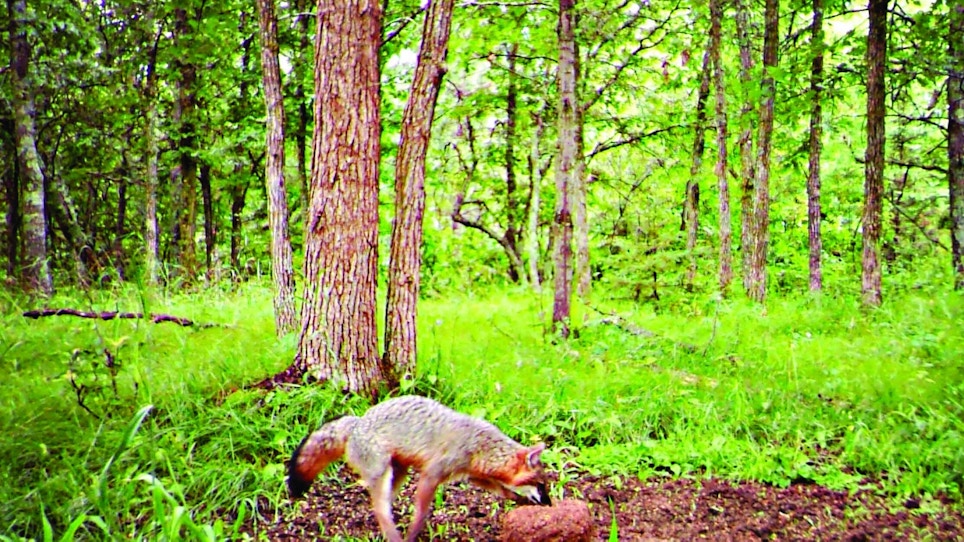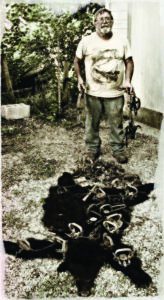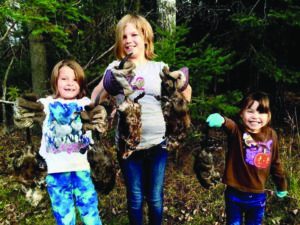Trail cameras can help by lending some insight into what's in the area, which takes out the guesswork when you're trapping and want to be efficient. (Photo: Michael Breuer)
Everyone has that one person in their life — a father, mother, uncle, family friend. Everyone has that one person who is typically known as “the trapper.”
In my case, my Uncle Don is my “the trapper.” He’s been trapping since well before my entrance into this world. He was the guy who’d wake me up on Saturday mornings to go to the bakery for coffee and doughnuts. He’s the guy that let me steer his old pickup truck in the empty K-Mart parking lot, my first time driving. He also introduced me to trapping.
Every childhood trapping memory I have involves my Uncle Don. He was always big into trapping, and he seems to find critters anywhere. Despite living seven hours away, whenever he’d come to visit in the fall, he’d bring traps and he’d collect fur. I was lucky enough to be able to tag along from time to time.
It was mostly on weekends, but sometimes I begged my parents to let me hang out with him instead of going to school. My uncle ran a lot of mink, muskrat and raccoon sets. He primarily trapped county ditches, river banks and small creeks. I’ll never forget the first critter he let me dispatch. Looking back, I wonder if it was one of those moments where he was trying to figure out if I was a trapper, or just a boy who wanted to skip school. I think I passed.
Skip ahead many years, grades, several sports obsessions, friends, girls, college, jobs, starting a family, etc. Long story short, life happened and my uncle wasn’t there to show me the way any longer.
There were short glimpses of the past, like when dad helped me catch a long-tailed weasel that was terrorizing him while working in his wood shop. Or the time I bought a few traps to catch the raccoons that kept stealing grouse from our deck.
But, as a whole, I had forgotten about trapping.
Spark Renews Trapping Flame
Jump ahead to a few years ago. I was on a writing assignment, covering a father-son duo that spent the first 10 days of Minnesota’s trapping season together running a sunrise-to-sunset trap line. They are lifelong trappers — the father taught the son, and the son will likely teach his children. Now, the father is retired and can’t get around like he used to, so he travels to the son’s house and lets him do most of the work. The son takes a week of vacation to keep their annual tradition alive.
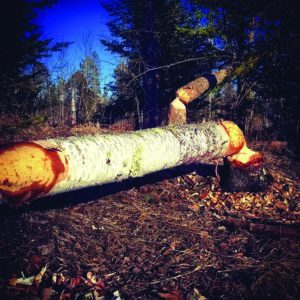
The damage a small colony of beavers can cause is clearly evident and gives trappers a starting point to make sets. (Photo: Michael Breuer)
Spending the day with this great pair lit a fire in me that I had calmed long ago. I had flashbacks of my childhood, I dug out the old traps I had in my shed, I started reading obsessively and thinking of areas I’d seen predators near my home. I was ready to rekindle my relationship with trapping.
Time has never really been on my side. Aside from writing, I work full time and own a year-round guiding business. I’m married, have two children and am a very avid hunter. I needed a partner to help run a line if I was going to run a worthy one, and I needed the blessing from my wife. Finding a partner was easy, as my best friend expressed interest and was more than willing to pitch in to get us started. Permission was also easy, as my wife enjoys the outdoors and the kids enjoy anything that involves suspense and surprise.
My partner in the new adventure and I had to set some rules if we were going to do things right. We sat down with an initial budget and tried to set a list of critters we wanted to pursue, things we needed and a rough line that would sweep us into good trapping areas and circle back toward our homes five miles apart. We decided that land animals would be our main target, as we knew where a lot of them lived.
Being a long-time licensed bear guide, I had locations on several fishers, ermine, fox and raccoons. We split the initial cost and bought about 25 traps, mostly used 1½ coil spring Dukes. I also had a couple of conibears lying around, and a few other footholds. We started with roughly 30 traps, enough tools and lures to get started and a dirt auger and sifter. I bought a pile of CCI .22LR ammunition for my SIG Mosquito and Savage FVXP.
We also added a couple of trail cameras that are designated for predator surveillance. The Bushnell Trophy Cam HD and the Primos Truth Cams are great for picking up passing critters. Aside from gray fox, we’ve found it very difficult to get several pictures of a critter at test baits or trap sites. We don’t need high-definition photos, though, just evidence that the critters are in the area. This helped me bag my first fisher, as I had it on camera for over a month.
Opening Day Happiness
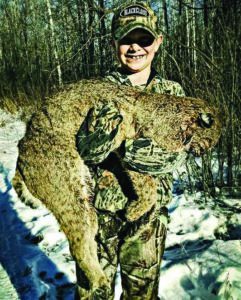
A bobcat is a top trapping trophy no matter what age, but young trappers certainly can get a big boost to their confidence with a big bob. (Photo: Michael Breuer)
Opening day came that first year and we were like two kids in a candy store. The candy store was huge, but we managed to eat, catching several raccoons and some skunks on our first checks. I think we even got two or three gray fox the first week. We felt like we were on top of the world.
We had decided to split any profits 50/50, but wound up reinvesting nearly all of our earnings that first season. At the end of a full season, we had picked up most of the species on our target list. Despite some dry spells and some tough conditions, we managed to build our arsenal to two full boxes of tools, lures, urines and roughly 80 traps.
We also learned more in the first year on the line that we could’ve learned reading or watching videos. There are so many subtleties that a person doesn’t notice until its right in front them, like a tree root sticking out of the dirt that a bobcat always steps in front of. Or the way a fox will walk a certain log every time is passes in the winter. Trapping is a thinking man’s game — and I love puzzles.
Solving Puzzles is Better
As much as I love the challenge of puzzles, I enjoy solving them even more. Presently, my partner and I have checked all but two species off of our “to-catch” list. Last season, despite a very poor fur market, I think we might have made enough to cover our fuel costs. There’s also an off-chance that we made $8 to boot.
We now own roughly 150 traps. Everything from homemade weasel boxes with rat traps inside, up to Minnesota Brand MB-650s for beaver. We’ve learned to trap water furbearers, and have added a lot to our line by adding a few water sets here or there.
We’ve also learned that several traps in an area is always a good idea. The old adage, “If a spot is good enough for one trap, it’s good enough for two” is always in the back of our minds, especially while snaring. You can find us making gang sets often, with four to five traps encircling a small area. And it’s usually true, if we catch a critter in a gang set area, there’s almost always another with it.
Aside from learning from set to set and year to year, I’ve picked up a couple of helpers that have taught me that it’s about more than catching. My son is nine and my daughter is six. They ran their first solo trap line last season for short-tailed weasels (ermine). Dad drove, and the kids baited, set, checked and collected. My son has also taken a liking to canids. He is obsessed with coyote hunting and fox trapping. He was even lucky enough to get a bobcat last season, a beautiful 27-pound tom that hangs on our fur wall.
It was a team effort, as we scouted together, chose locations and made the sets and checked the traps together, typically followed by a root beer, cheese curds and a game or two of bubble hockey at a small out-of-town eatery. I don’t think it would’ve mattered one bit if we had caught a thing, but the smile on his face when we did was priceless.
My daughter, not to be outdone, chose the locations for beaver sets this spring on a daddy/daughter day, and we got our biggest beaver to date from one of her sets. That hide also hangs on our wall. She talks more about where she put the set than the size of the beaver.
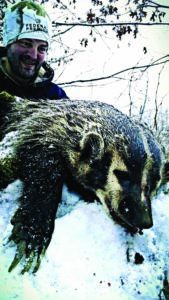
Tim Ferch, the author's trapping partner, with a badger they caught less than a mile from the author's home.
Longtime Bond is Strong
If there’s anything I’ve learned over the years from trapping, it’s that there’s an unwritten bond between trappers. Man or woman, young or old, the trapping community is one of the most open and helpful groups of outdoorsmen out there.
Sharing spots or tips and tricks — no problem. Need to borrow a trap or two from someone you’ve only met once? You’d be hard-pressed to find a trapper that would turn you down.
It truly is a tradition, one that built this country. It’s an important tradition, which every trapper needs to pass on to someone. If their kids try it and don’t enjoy it, find a friend who might.
Trapping is an art, but I’m afraid it’s a dying one. With the fur market being poor, fewer trappers are hitting the creeks and fields. While money is nice, spending time outdoors, getting to know the animals that surround us is worth more than any piece of paper in your wallet. Add time spent with people you care about and you’re surely rich, even if it’s only until the last trap of the day is checked.
More top picks from Predator Xtreme:
How to scout in summer for coyotes
3 tips to hunt coyotes the simplest way possible
Coyote 101: Understanding how songdogs rear pups
Wild hogs: A must-hunt species
